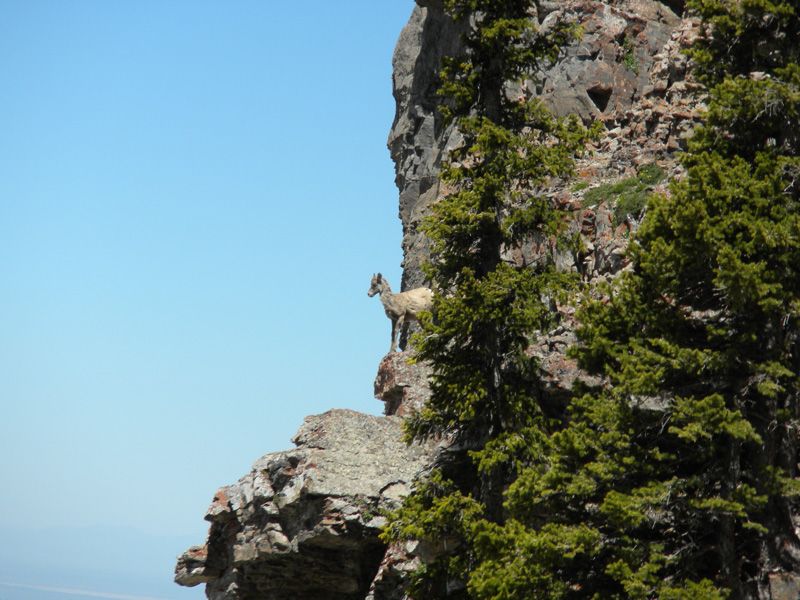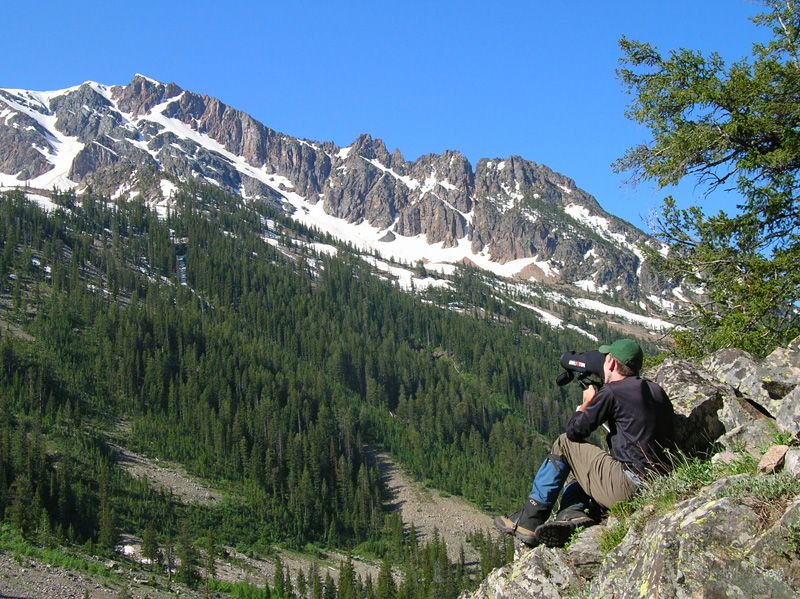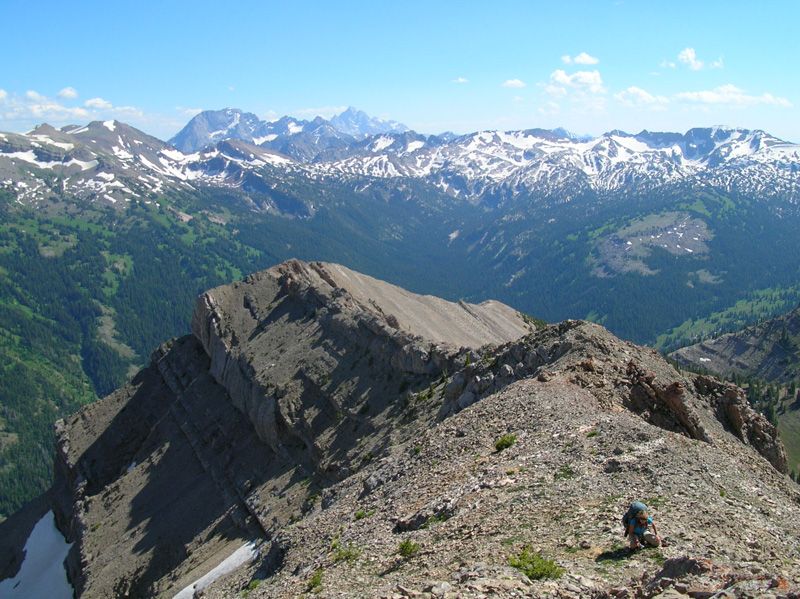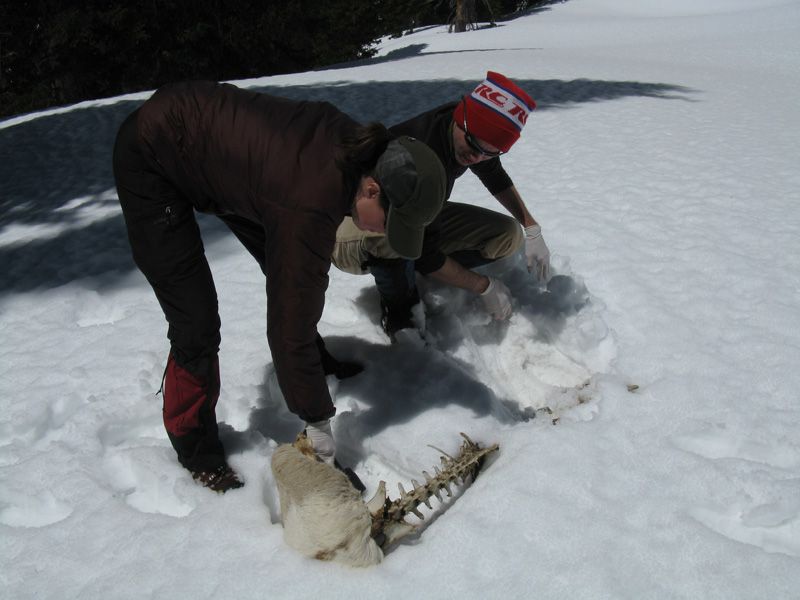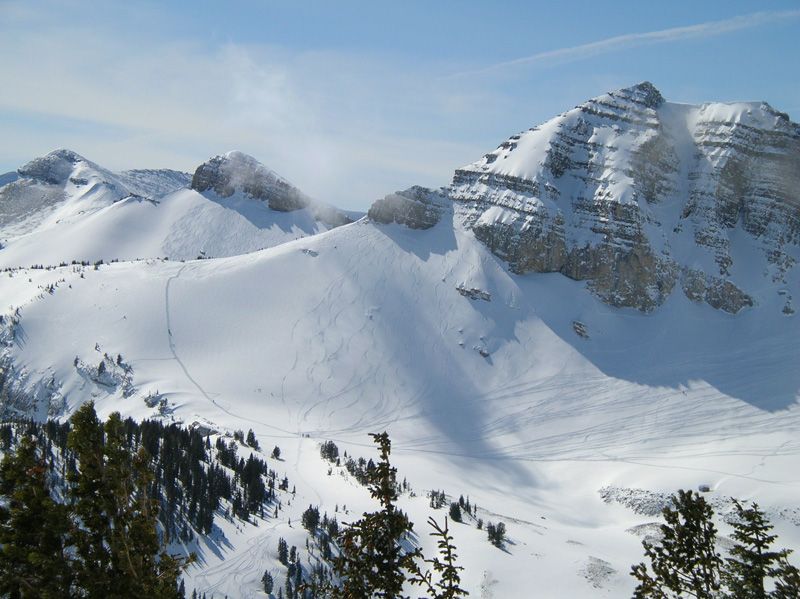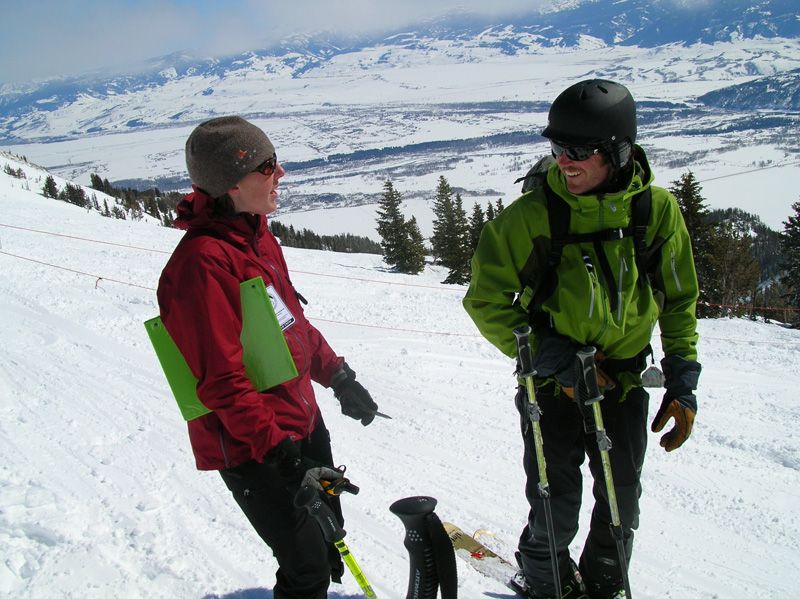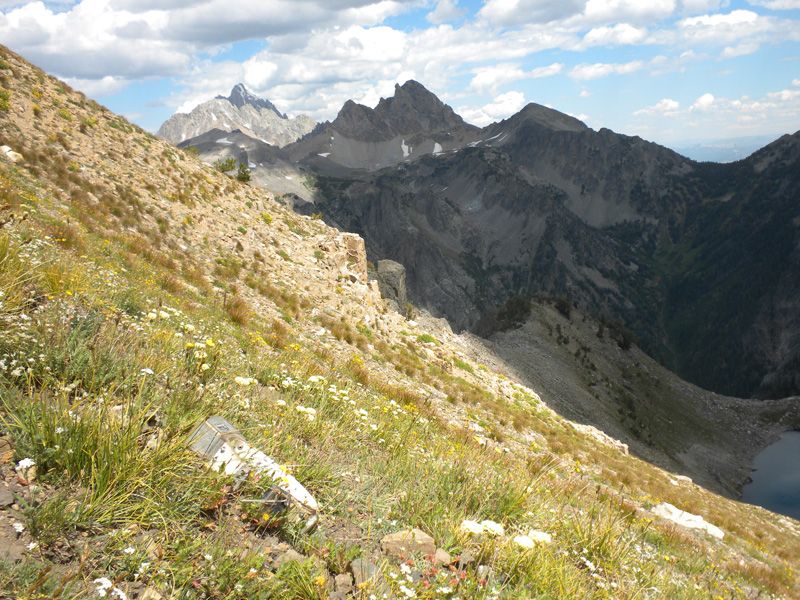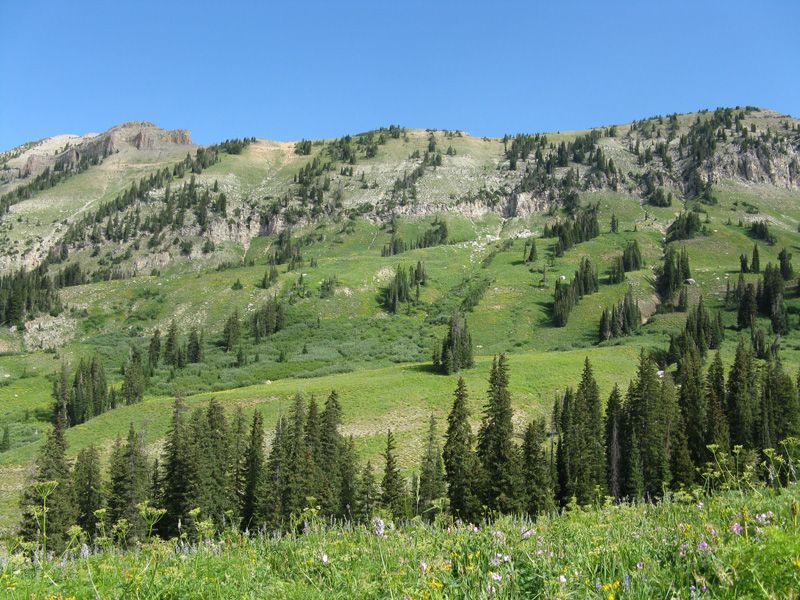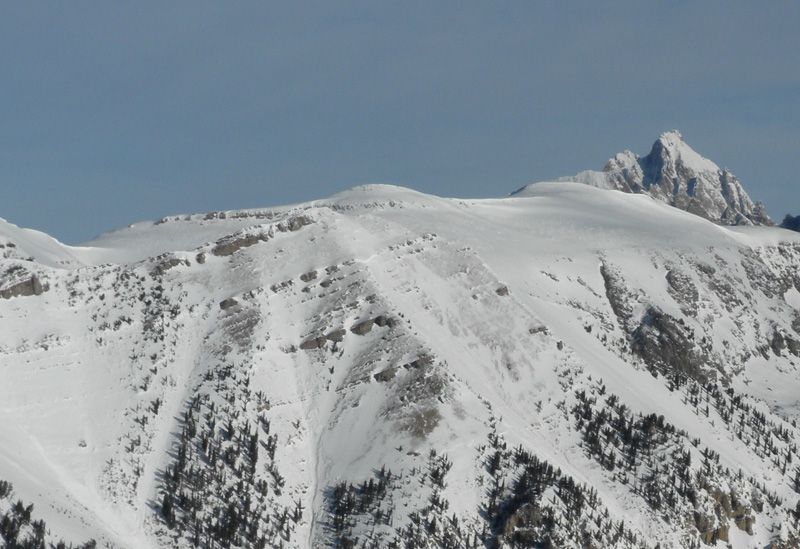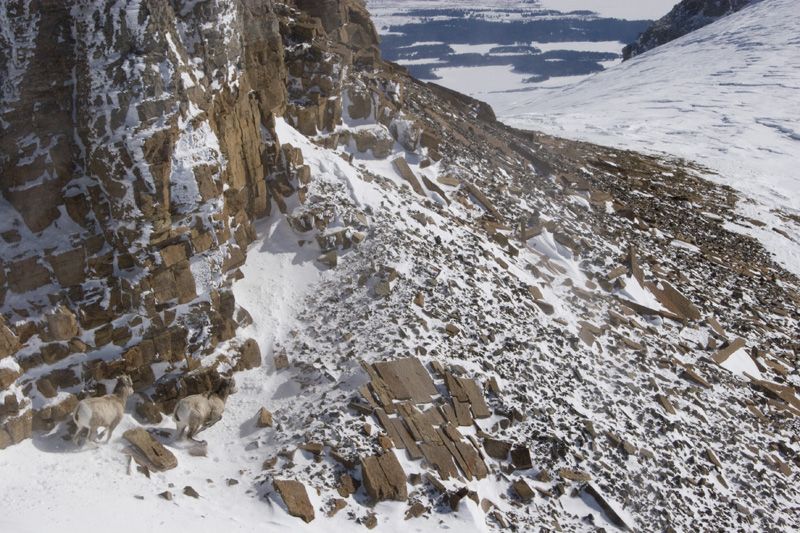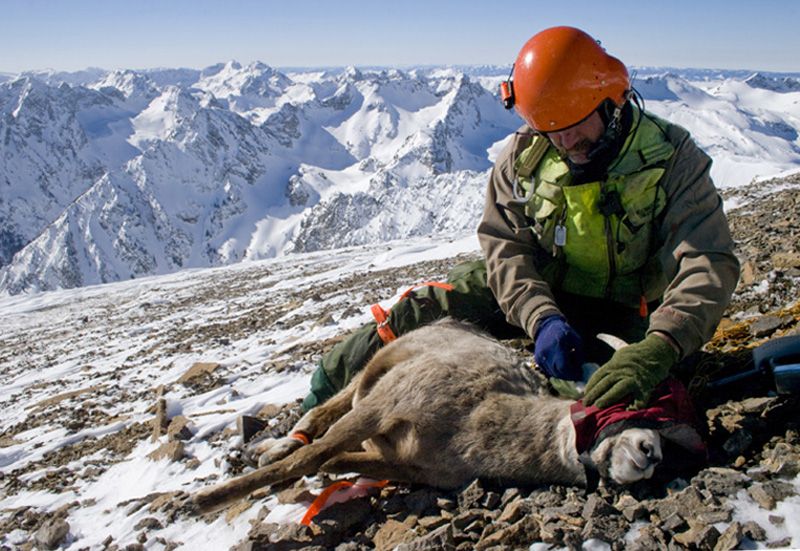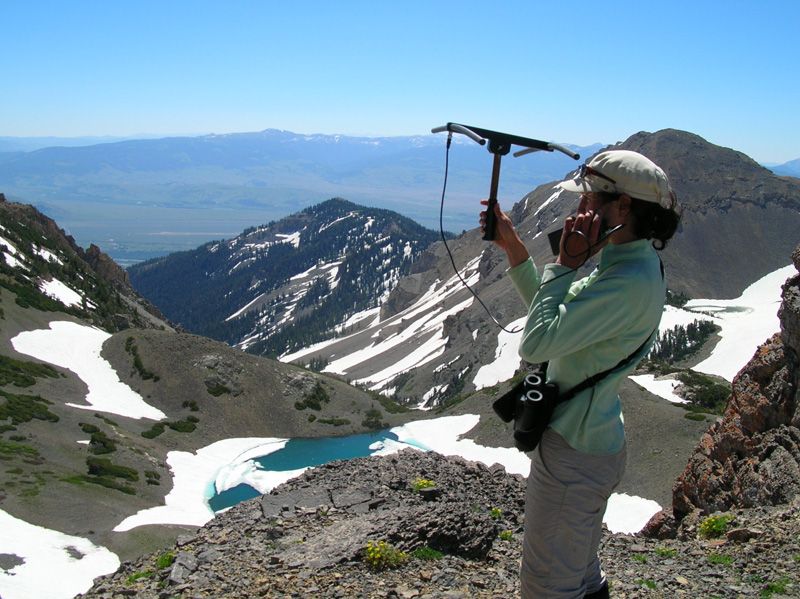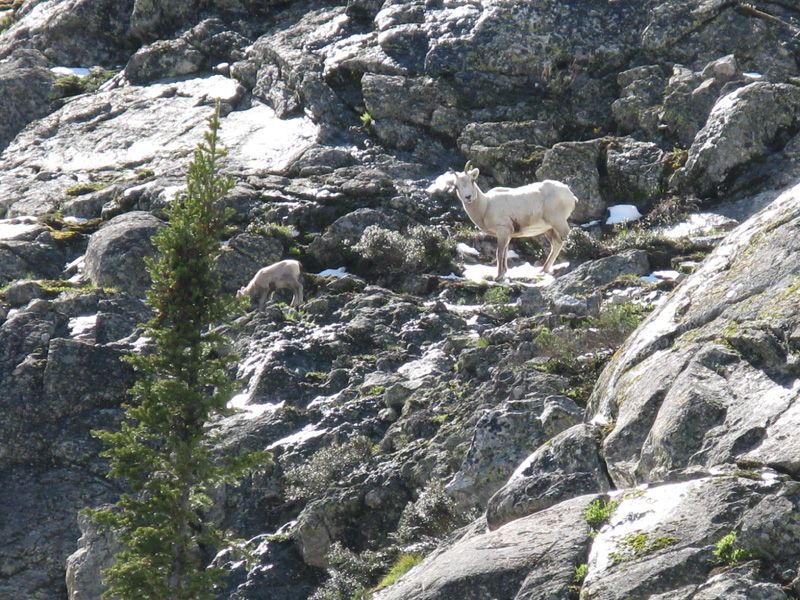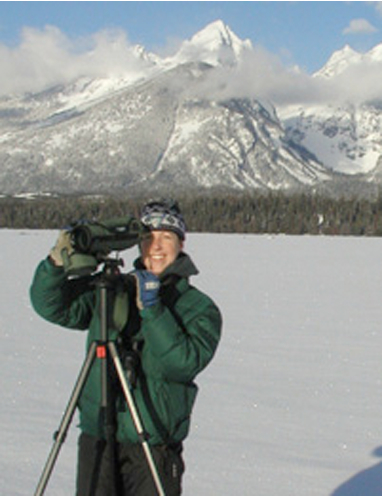Loss of migration patterns and access to seasonal ranges are threats facing ungulate populations throughout the world. Historically, bighorn sheep in the Teton Range near Jackson Hole, Wyoming undertook an annual migration from high elevation summer range to low elevation winter range. However, the combined effects of human settlement, livestock grazing, and other factors led to the disruption and loss of migration around 50 years ago. The herd currently resides year-round at high elevation (8,000 to 12,000 feet) in Grand Teton National Park and on the Bridger-Teton and Caribou-Targhee National Forests. It is Wyoming’s smallest and most isolated native herd – a remnant population of approximately 100-150 sheep. However, the population’s hold on the future is tenuous owing to its small size, genetic isolation from surrounding herds, marginal winter habitat, and potential disturbance from winter backcountry recreation.
Growing recognition of the status of the herd and the need for interagency cooperation in management led to the formation of the Teton Range Bighorn Sheep Working Group in 1990 and the development of a strategic plan. The strategic plan recognized that the existing information regarding the status and threats to this herd was inadequate. Thus, the primary goal of our project is to conduct research that is closely aligned with the knowledge gaps and management needs outlined in the strategic plan.
The specific objectives are to 1) evaluate the summer and winter habitat selection strategies of the herd, 2) assess whether and how bighorn sheep avoid winter habitats due to backcountry recreation, 3) evaluate bighorn sheep use of retired domestic sheep allotments, 4) determine lamb survival through summer for a sample of bighorn ewes, and 5) evaluate summer diet selection and time-budgets. Results from this study will inform future management decisions regarding refinement or addition of seasonal closures, habitat enhancements, justification for or against a future transplant, and expansion of human development. We also hope to shed light on how these bighorn sheep have adapted behaviorally to wintering on high elevation range, as such information would better our understanding of how loss of migration influences ungulate populations.
During winters 2008 and 2009, we captured and GPS-collared 28 bighorn ewes in the Teton Range. The GPS collars provide 5-hour fixes of bighorn sheep locations for 2.5 or 1.5 years. These GPS locations are being used to develop summer and winter resource selection functions describing bighorn sheep habitat selection throughout the Teton Range. We have also collected data on human backcountry recreation patterns (i.e., backcountry skiers) in winters 2009 and 2010 by establishing trail counters and recruiting backcountry users at 11 trailheads to carry handheld GPS units, yielding over 800 GPS tracks of backcountry use. The recreation data is directly comparable to GPS locations from collared bighorn sheep collected during the same period. Also, during summers 2008-2010, field crews tracked GPS-collared ewes to monitor lamb survival, collect fecal samples for diet selection analysis, conduct vegetation surveys, and collect time-budget observations.
This is a collaborative project involving our research group, the Wyoming Game and Fish Department, Grand Teton National Park, and Bridger-Teton and Caribou-Targhee National Forests.
Click here to go to the Teton Bighorn Sheep Project Blog
Gallery
The Teton Range bighorn sheep herd is the smallest and most isolated native bighorn sheep herd in Wyoming, numbering at around 100-150 individuals. Historically, the herd summered at high elevation in the Teton Range and migrated to lower elevations in wi
The Teton Range bighorn sheep herd is the smallest and most isolated native bighorn sheep herd in Wyoming, numbering at around 100-150 individuals. Historically, the herd summered at high elevation in the Teton Range and migrated to lower elevations in winter in the surrounding valleys. However, the combined effects of a number of anthropogenic factors disrupted these migration patterns and migration ceased around 1950. Currently, the herd is non-migratory and survives year-round at high elevation in the Teton Range.
Field crews conducted time-budget observations on bighorn sheep in order to determine percent of time spent feeding, vigilant, and bedded. These data will be compared to time-budgets from other bighorn sheep populations in order to understand if Teton Ran
Field crews conducted time-budget observations on bighorn sheep in order to determine percent of time spent feeding, vigilant, and bedded. These data will be compared to time-budgets from other bighorn sheep populations in order to understand if Teton Range bighorn sheep behave differently during summer in order to compensate for living on marginal, high elevation winter range.
Field crews collected bighorn sheep fecal samples and conducted vegetation surveys during summers 2008, 2009, and 2010 to compare diet selection and forage availability on summer range.
Field crews collected bighorn sheep fecal samples and conducted vegetation surveys during summers 2008, 2009, and 2010 to compare diet selection and forage availability on summer range.
Eight GPS-collared bighorn sheep died during the study period (2.5 years). The majority of bighorn sheep died in avalanches (4), one died from mountain lion predation during winter, and 3 died of unknown causes during winter (field crews could not reach t
Eight GPS-collared bighorn sheep died during the study period (2.5 years). The majority of bighorn sheep died in avalanches (4), one died from mountain lion predation during winter, and 3 died of unknown causes during winter (field crews could not reach the carcass in time to determine the cause).
Winter backcountry skiing, snowboarding, and mountaineering are becoming increasingly popular in the Teton Range. A few areas experience relatively high levels of winter backcountry recreation on National Forest and National Park lands. This photo shows b
Winter backcountry skiing, snowboarding, and mountaineering are becoming increasingly popular in the Teton Range. A few areas experience relatively high levels of winter backcountry recreation on National Forest and National Park lands. This photo shows backcountry ski and snowboard tracks on Bridger-Teton National Forest in an area which is accessed from the Jackson Hole Mountain Resort. Wildlife biologists and managers are concerned that disturbance from backcountry recreation could displace bighorn sheep from important winter range areas.
To determine if and how bighorn sheep winter habitat selection is influenced by backcountry recreation activity, we contacted backcountry users at 11 access points in the Teton Range in winters 2009 and 2010 and asked them to carry handheld GPS units for
To determine if and how bighorn sheep winter habitat selection is influenced by backcountry recreation activity, we contacted backcountry users at 11 access points in the Teton Range in winters 2009 and 2010 and asked them to carry handheld GPS units for the day. GPS units collected information on the patterns of backcountry travel, which can be directly compared to GPS-collared bighorn sheep movements. In total, we collected over 800 GPS tracks of backcountry use.
On July 15, 2010, the GPS collars automatically detached from the bighorn sheep and we collected them from the field. GPS fixes were downloaded from each collar, resulting in over 60,000 locations of bighorn sheep use in the Teton Range. These data will b
On July 15, 2010, the GPS collars automatically detached from the bighorn sheep and we collected them from the field. GPS fixes were downloaded from each collar, resulting in over 60,000 locations of bighorn sheep use in the Teton Range. These data will be used to develop summer and winter habitat selection models, and inform future management of the Teton Range bighorn sheep herd.
Bighorn sheep summer range in the Tetons is characterized by steep slopes covered with grasses and forbs, usually close to rocky escape terrain. During early summer, it is common to see bighorn sheep ewes and lambs at natural mineral licks in cliffs.
Bighorn sheep summer range in the Tetons is characterized by steep slopes covered with grasses and forbs, usually close to rocky escape terrain. During early summer, it is common to see bighorn sheep ewes and lambs at natural mineral licks in cliffs.
Prior to the mid-20th century, Jackson Hole served as winter range for the Teton Range bighorn sheep herd, as well as the nearby Jackson bighorn sheep herd, which summers in the Gros Ventre Range. Mixing of individuals on winter range probably facilitated
Prior to the mid-20th century, Jackson Hole served as winter range for the Teton Range bighorn sheep herd, as well as the nearby Jackson bighorn sheep herd, which summers in the Gros Ventre Range. Mixing of individuals on winter range probably facilitated gene flow between herds, but loss of migration routes and access to traditional winter range has led to genetic isolation of the Teton Range herd.
Bighorn sheep winter range in the Tetons is characterized by high elevation, windswept ridgelines and slopes. Mt. Hunt (10,783 ft.) and Prospectors Mountain (11,241 ft.), pictured here, are used extensively by bighorn sheep during winter. This study will
Bighorn sheep winter range in the Tetons is characterized by high elevation, windswept ridgelines and slopes. Mt. Hunt (10,783 ft.) and Prospectors Mountain (11,241 ft.), pictured here, are used extensively by bighorn sheep during winter. This study will determine the extent of movement by bighorn sheep between isolated patches of windswept terrain.
Cold temperatures, marginal forage, and risk of avalanches present constant challenges to bighorn sheep winter survival. This study examines, in part, how bighorn sheep have adapted their habitat selection strategies in order to live on high elevation ran
Cold temperatures, marginal forage, and risk of avalanches present constant challenges to bighorn sheep winter survival. This study examines, in part, how bighorn sheep have adapted their habitat selection strategies in order to live on high elevation range year-round in the Teton Range. Photo: Mark Gocke, WGFD
During winters 2008 and 2009, we deployed GPS store-on-board collars on 28 bighorn sheep ewes in the Teton Range. Sheep were captured by net-gunning from a helicopter. Besides GPS-collaring, we also collected blood and fecal samples for pregnancy and para
During winters 2008 and 2009, we deployed GPS store-on-board collars on 28 bighorn sheep ewes in the Teton Range. Sheep were captured by net-gunning from a helicopter. Besides GPS-collaring, we also collected blood and fecal samples for pregnancy and parasite analysis, and ear, nose, and tonsil swabs for disease analysis. Ninety-three percent of ewes were pregnant at time of capture, and all ewes tested negative for 12 common bighorn sheep diseases. Photo: Mark Gocke, WGFD
Bighorn sheep ewes were GPS-collared for 2.5 or 1.5 years, depending on date of capture. The GPS collars were programmed to record a location every 5 hours, providing detailed habitat use data throughout the year. GPS store-on-board collars save the data
Bighorn sheep ewes were GPS-collared for 2.5 or 1.5 years, depending on date of capture. The GPS collars were programmed to record a location every 5 hours, providing detailed habitat use data throughout the year. GPS store-on-board collars save the data inside the collar, so it is inaccessible to researchers until the collar is retrieved.
Field crews tracked GPS-collared bighorn sheep using radio-telemetry during summers 2008, 2009, and 2010.
Field crews tracked GPS-collared bighorn sheep using radio-telemetry during summers 2008, 2009, and 2010.
Field crews located GPS-collared ewes throughout the summer in order to track lamb survival. We found that lamb survival through late summer was typical, compared to other bighorn sheep populations, ranging from 50-60% in summers 2008, 2009, and 2010. Mos
Field crews located GPS-collared ewes throughout the summer in order to track lamb survival. We found that lamb survival through late summer was typical, compared to other bighorn sheep populations, ranging from 50-60% in summers 2008, 2009, and 2010. Most lamb mortalities occurred within a few weeks of birth.
Reports & Publications
D’Antonio, A., C. Monz, S. Lawson, P. Newman, D. Pettebone, and A. Courtemanch. 2010. GPS-based measurements of backcountry visitors in parks and protected areas: examples of methods and applications from three case studies. Journal of Park and Recreation Administration 28:42-60.
Project Reports
Annual Report 2010
Annual Report 2009– for UW-NPS Research Center
Contact
Alyson Courtemanch, M.S. candidate
Wyoming Cooperative & Wildlife Research Unit
Dept. 3166, 1000 E. University Avenue, Laramie, WY 82070
[email protected] | lab: (307) 766-6415 | cell: (207) 441-2692
Steve Kilpatrick, Habitat Biologist
Wyoming Game & Fish Department
420 North Cache, P.O. Box 67, Jackson, WY 83001
[email protected] | office: (307) 733-2321
Sarah Dewey, Wildlife Biologist
Grand Teton National Park
P.O. Drawer 170, Moose, WY 83012
[email protected] | office: (307) 739-3480
Doug Brimeyer, Wildlife Biologist
Wyoming Game & Fish Department
420 North Cache, P.O. Box 67, Jackson, WY 83001
[email protected] | office: (307) 733-2321
Project Lead
Alyson Courtemanch is currently an M.S. student in the Wyoming Cooperative Fish & Wildlife Research Unit at the University of Wyoming. Aly earned a B.S. in Biology and Environmental Studies from St. Lawrence University in 2005.
Timeline
The project started in January 2008. Initial bighorn sheep captures took place in February 2008 and a second round of captures took place in March 2009. Field work was conducted during winters 2008/2009 and 2009/2010 and summers 2008, 2009, and 2010. The GPS collars dropped off on 15th July 2010 and were collected by September 2010. Analysis is taking place during fall and winter 2010/2011, and final reports will be completed by August 2011.
Funding & Partners
Wyoming Governor’s Big Game License Coalition • Wyoming Chapter of the Wild Sheep Foundation • Wyoming Game & Fish Department • Grand Teton National Park – Rocky Mountain Ecosystems Studies Unit • Teton Conservation District • Grand Teton National Park Foundation • Bridger-Teton and Caribou-Targhee National Forests • Greater Yellowstone Coordinating Committee • National Park Service – University of Wyoming AMK Ranch • Eastern Chapter of the Wild Sheep Foundation
Other Project Coordinators
Jackson Hole Mountain Resort • Grand Targhee Resort • Rendezvous Backcountry Tours • Brunton, Inc. • Jetboil, Inc.



